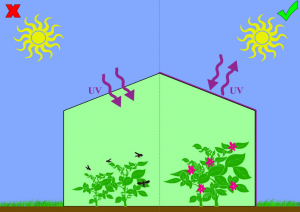Effects of our films
The following effects and properties improve greenhouse crop quantity and quality.
Thermal Effect
These films contain IR and EVA additives with specific formulations to:


Anti-drip effect
Water drops formed on the underside of greenhouse films can negatively affect plant quality and growth due to the density of water. This can also reduce light transmission by 15–30% and increase the likelihood of some diseases. On anti-drip films, however, large water drops constantly break down to form a thin layer of water, which eventually flows from the underside of the greenhouse ceiling down to the walls.
Advantages of anti-drip films

Light transmission effect
The light transmission factor determines the amount of light that enters the greenhouse from the outside. Light transmission within the range of 400–700 nm is required for photosynthesis and other purposes, such as maintaining the optimal form and color of crops.
Light diffusion effect
This feature improves light diffusion in the greenhouse interior, which in turn increases the rate of photosynthesis to a great extent. Studies have shown that light diffusion has a positive effect on plant growth, especially for spring and summer crops and in regions with intense sun exposure. Light diffusion reduces shadows, guarantees a more even distribution of light in the greenhouse insofar as light reaches even the lower parts of plants, prevents burns, and creates a moderate cooling effect. This quality is especially important for reducing the shadow of tall plants.

Disease control effect
One seemingly simple and fast pest control method is chemical control, namely using pesticides. However, the risks and the high cost of using pesticides are well-known facts. Therefore, other methods, including biological control and using UV blocking films, come as great alternatives. Not getting enough access to ultraviolet radiation makes some insects, such as thrips, vulnerable — pests locate their targets in the ultraviolet spectrum. We deny this wavelength from greenhouse pests by using additives in our films, and by doing so, help control diseases.
Advantages of UV blocking films include::

Since the spread of diseases is also influenced by parameters such as temperature and humidity, plastic films might not be able to control diseases alone; however, using them together with other methods can be effective in controlling diseases.

Selective light transmission (Photo-selective films)
Greenhouse films can be designed to only allow the passage of a specific wavelength to protect crops against some solar wavelengths and speed up plant growth or improve crop quality. For instance, using photo-selective films in rose greenhouses increases crop productivity and improves flower color quality and consistency.
